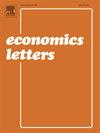通过消费者情绪来衡量对通胀的厌恶程度
IF 1.8
4区 经济学
Q2 ECONOMICS
引用次数: 0
摘要
我们建议使用个人消费者情绪和通胀预期之间的关系作为通胀厌恶的动态代理。我们发现消费者信心和他们自己的通胀预期之间存在强烈的负相关,尤其是在低通胀时期。当比较同一个人的情绪和通胀预期时,这种关系在一段时间内成立,这表明他们确实厌恶通胀。我们提出的指标表明,在美国央行采用2%的通胀目标后,消费者对2%的通胀预期仍然比零通胀预期更反感。本文章由计算机程序翻译,如有差异,请以英文原文为准。
Gauging inflation aversion through the lens of consumer sentiment
We propose using the relationship between individual consumer sentiment and inflation expectations as a dynamic proxy for inflation aversion. We find a robust negative association between consumer sentiment and their own inflation expectations, especially during times of low inflation. This relationship holds when comparing the same individual’s sentiment and inflation expectations over time, suggesting a genuine inflation aversion. Our proposed metric indicates that, after the U.S. central bank adopted a 2-percent inflation target, consumers continued to be more averse to expectations of 2-percent than zero inflation.
求助全文
通过发布文献求助,成功后即可免费获取论文全文。
去求助
来源期刊

Economics Letters
ECONOMICS-
CiteScore
3.20
自引率
5.00%
发文量
348
审稿时长
30 days
期刊介绍:
Many economists today are concerned by the proliferation of journals and the concomitant labyrinth of research to be conquered in order to reach the specific information they require. To combat this tendency, Economics Letters has been conceived and designed outside the realm of the traditional economics journal. As a Letters Journal, it consists of concise communications (letters) that provide a means of rapid and efficient dissemination of new results, models and methods in all fields of economic research.
 求助内容:
求助内容: 应助结果提醒方式:
应助结果提醒方式:


